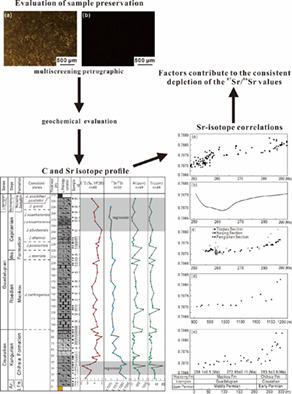当前位置:
X-MOL 学术
›
Geolog. J.
›
论文详情
Our official English website, www.x-mol.net, welcomes your
feedback! (Note: you will need to create a separate account there.)
Early–Middle Permian strontium isotope stratigraphy of marine carbonates from the northern marginal areas of South China: Controlling factors and implications
Geological Journal ( IF 1.4 ) Pub Date : 2020-10-18 , DOI: 10.1002/gj.4010 Qian Li 1, 2 , Karem Azmy 2 , Shuai Yang 1 , Sheng‐Lin Xu 1 , Di Yang 3 , Xi‐Hua Zhang 4 , An‐Qing Chen 1 , Hong‐De Chen 1, 3
Geological Journal ( IF 1.4 ) Pub Date : 2020-10-18 , DOI: 10.1002/gj.4010 Qian Li 1, 2 , Karem Azmy 2 , Shuai Yang 1 , Sheng‐Lin Xu 1 , Di Yang 3 , Xi‐Hua Zhang 4 , An‐Qing Chen 1 , Hong‐De Chen 1, 3
Affiliation

|
The radiogenic strontium isotope (87Sr/86Sr) system is a powerful tool for constraining sea‐level change and palaeoclimatic variations as well as tectonic activities. The Permian is a period that records the lowest seawater Sr‐isotopic ratios in the Earth's history. The near‐primary geochemical signatures retained in the micritic carbonates of the Luduba section (uppermost lower to Middle Permian) on the northern margin of the South China Block allowed the reconstruction of reliable carbon and Sr‐isotope profiles for global chemostratigraphic correlations. The investigated interval (~300 m) spans the Chihsia and overlying Maokou formations (Kungurian to Capitanian series). The 87Sr/86Sr values decrease consistently upward from 0.70833 to 0.70684, and their trend correlates well with a long‐term increase in the carbon isotope (δ13C) values. The negative correlation between the 87Sr/86Sr and δ13C values suggests that the sea‐level change, climatic conditions, opening of the Neo‐Tethys Ocean, and accretion of the Pangean Supercontinent are among the factors that might have contributed to the consistent depletion of the 87Sr/86Sr values. The rate of upward decrease in 87Sr/86Sr values throughout the Chihsia Formation is generally higher than that of the overlying Maokou Formation, which provides a possible marker for intra‐ and interbasinal basin stratigraphic correlations. The general increase in the δ13C values of the Luduba profile peaks at ~5‰, which correlates with the distinct lowest 87Sr/86Sr value (~0.70684) near the top of the Maokou Formation (Upper Capitanian). The δ13C values decrease to 3.6‰ at the top of the Maokou Formation, that correlates with the rapid sea‐level drop in the Late Guadaualupian worldwide. Meanwhile, the87Sr/86Sr ratios remain low values, probably due to the development of cold climate, increasing input of hydrothermal flux and low terrestrial runoff.
更新日期:2020-10-18











































 京公网安备 11010802027423号
京公网安备 11010802027423号